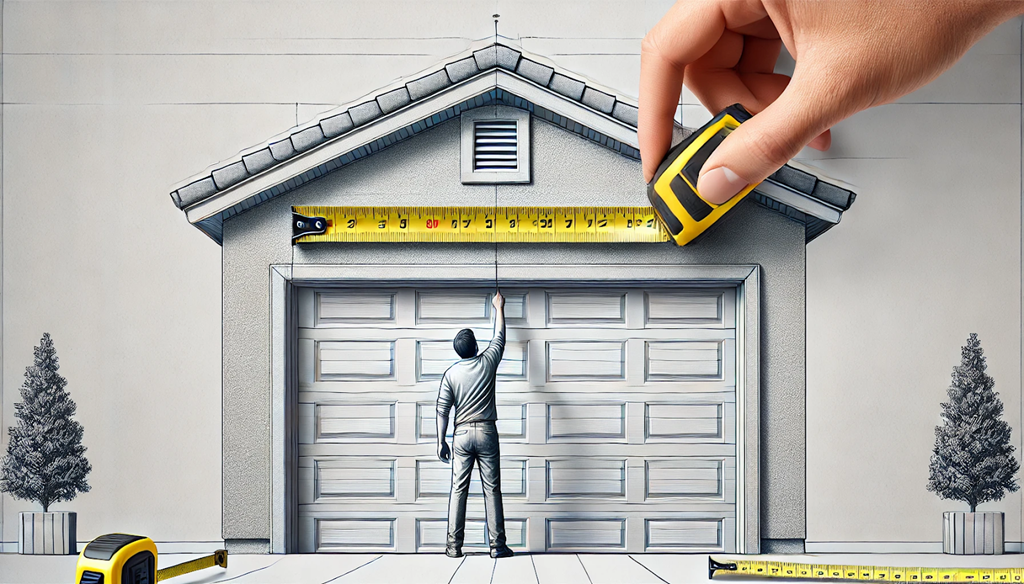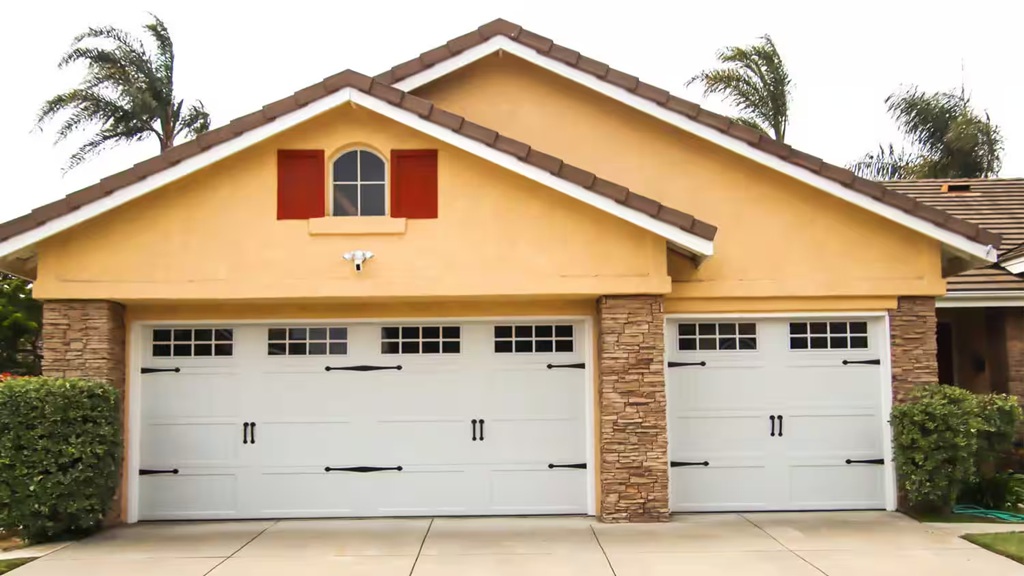Your garage door isn’t just a functional entry point; it’s a major visual element that significantly impacts your home’s curb appeal. Choosing the right size is crucial, not only for aesthetic reasons but also for smooth operation and optimal functionality. This comprehensive guide dives deep into standard garage door sizes, helping you navigate the world of single, double, and even triple garage doors with ease. We’ll explore common dimensions, and factors influencing size, and answer frequently asked questions to empower you to make the perfect choice for your home.
Standard Garage Door Sizes: A Quick Overview
While garage doors can be custom-made to fit unique openings, most homes utilize standard sizes. This simplifies the selection process and often proves more cost-effective.
Let’s break down the common dimensions for single and double garage doors:
Single Garage Doors:
- Width: 8 feet, 9 feet, 10 feet
- Height: 7 feet, 8 feet
Double Garage Doors:
- Width: 12 feet, 14 feet, 16 feet, 18 feet
- Height: 7 feet, 8 feet
These dimensions cater to the majority of vehicles, from compact cars to larger SUVs and trucks. However, it’s essential to remember that these are just standard sizes. Variations exist, and your ideal size will depend on your specific needs and the dimensions of your garage opening.
Factors Influencing Garage Door Size
Choosing the right garage door size isn’t a one-size-fits-all scenario.
Several factors come into play, influencing the ideal dimensions for your home:
- Vehicle Type: The size and type of vehicle you own play a crucial role. A compact car can comfortably fit through an 8-foot wide door, while a large truck or SUV might require a 9 or 10-foot wide opening. If you anticipate owning larger vehicles in the future, it’s wise to factor that into your decision.
- Garage Usage: Do you use your garage solely for parking, or does it double as a workshop or storage space? If you require extra room for hobbies, equipment, or maneuvering around stored items, consider a larger door size.
- Future Needs: Think about your future plans. Do you plan on adding to your family or acquiring recreational vehicles like motorcycles or ATVs? Choosing a larger door now can save you the hassle and expense of replacing it later.
- Architectural Style: The architectural style of your home can also influence your choice. A wider door might complement a larger home, while a smaller door might be more proportionate for a cozy bungalow.
Measuring Your Garage Door: A Step-by-Step Guide
Accurate measurements are paramount when selecting a new garage door.
Here’s a step-by-step guide to help you get it right:
- Measure the Width: Use a tape measure to determine the width of the garage door opening. Measure from the inside edge of one side jamb to the inside edge of the other.
- The Height: Measure the height from the floor to the underside of the lintel (the horizontal beam above the opening). Ensure the floor is level for accurate measurement.
- Account for Headroom and Sideroom: Headroom is the space between the top of the door opening and the ceiling. Sideroom refers to the space between the sides of the door opening and the garage walls. Adequate headroom and side room are essential for accommodating the garage door tracks and opener mechanism.
- Note any Obstructions: Take note of any potential obstructions, such as light fixtures, pipes, or ductwork, that might interfere with the door’s operation.
Beyond the Basics: Exploring Different Garage Door Styles
While size is a critical factor, it’s also essential to consider the style of your garage door. Different styles offer varying levels of functionality, insulation, and aesthetic appeal.
Here are some popular options:
- Sectional Garage Doors: These are the most common type, consisting of horizontal panels that roll up and along the garage ceiling. They offer excellent insulation, smooth operation, and a variety of design options.
- Roll-up Garage Doors: Made from horizontal slats that coil around a drum above the opening, roll-up doors are ideal for garages with limited headroom. They are durable and secure, often used in commercial settings.
- Tilt-up Canopy Doors: These doors tilt up and outwards before resting parallel to the garage ceiling. They are a cost-effective option but offer less insulation and security compared to sectional doors.
- Side-hinged Garage Doors: Resembling large barn doors, these swing open from the sides. They offer a unique aesthetic but require ample sideroom and may not be suitable for all climates.
Garage Door Size Chart: A Visual Guide
To further assist you in your decision-making process, here’s a comprehensive garage door size chart:
| Door Type | Width (feet) | Height (feet) | Common Applications |
| Single | 8 | 7 | Standard single-car garages, compact cars |
| 9 | 7 | Most common size for single-car garages, SUVs, minivans | |
| 10 | 7 | Larger vehicles, extra storage space | |
| 8 | 8 | Garages with higher ceilings, taller vehicles | |
| 9 | 8 | Most common size for taller garages, SUVs, trucks | |
| 10 | 8 | Larger vehicles, ample headroom | |
| Double | 12 | 7 | Standard double-car garages, two compact cars |
| 14 | 7 | A most common size for double car garages, two standard vehicles | |
| 16 | 7 | Larger vehicles, extra storage space | |
| 18 | 7 | Three-car garages, oversized vehicles, workshops | |
| 12 | 8 | Double-car garages with higher ceilings | |
| 14 | 8 | Most common size for taller double garages, SUVs, trucks | |
| 16 | 8 | Larger vehicles, ample headroom | |
| 18 | 8 | Three-car garages, maximum space |
Export to Sheets
Triple Garage Doors: Accommodating Larger Needs
For homeowners with multiple vehicles or expansive garages, triple garage doors provide ample space and flexibility.
These doors come in various configurations, including:
- Three single doors: This setup offers maximum versatility, allowing you to open each door individually as needed.
- One double door and one single door: A popular choice that combines practicality with aesthetic appeal.
- One large triple door: This option creates a grand entrance but may require more powerful openers and specialized installation.
Common sizes for triple garage doors include widths of 21, 24, 27, and 30 feet, with heights of 7 or 8 feet.
Related: Decoding Garage Door Dimensions: A Comprehensive Guide to Standard Sizes in the USA
RV Garage Doors: Sizing Up for Recreational Vehicles
If you own an RV, boat, or other large recreational vehicle, you’ll need a garage door that can accommodate its height and width. RV garage doors typically come in larger sizes and offer higher headroom clearance.
Standard RV garage door sizes include:
- Width: 10 feet, 12 feet, 14 feet, 16 feet, and wider
- Height: 8 feet, 10 feet, 12 feet, and taller
When choosing an RV garage door, consider the specific dimensions of your vehicle, including any roof-mounted accessories. It’s also crucial to ensure your garage has sufficient depth to accommodate the length of your RV.
Garage Door Size FAQ: Answering Your Burning Questions
-
What is the most common garage door size?
For single-car garages, the most common size is 9 feet wide by 7 feet high. For double-car garages, 16 feet wide by 7 feet high is the standard.
-
Can I install a garage door myself?
While it’s possible to DIY a garage door installation, it’s generally recommended to hire a professional. Garage doors are heavy and complex, and improper installation can lead to safety hazards and operational issues.
-
How much does a new garage door cost?
The cost of a new garage door varies depending on size, material, style, and installation fees. On average, you can expect to pay between $700 and $1,800 for a single garage door and $1,200 to $3,500 for a double garage door.
-
What is the R-value, and why is it important?
R-value measures a garage door’s insulation level. A higher R-value indicates better insulation, which can help regulate temperatures in your garage and improve energy efficiency.
-
How do I choose the right garage door material?
Common garage door materials include steel, wood, aluminum, and fiberglass. Each material offers different benefits in terms of durability, maintenance, and aesthetics. Consider your budget, climate, and personal preferences when making your selection.
-
How long do garage doors typically last?
With proper maintenance, a garage door can last 15 to 30 years. Regular inspections, lubrication, and timely repairs can extend its lifespan.
-
Can I increase the height of my garage door opening?
Yes, it’s possible to increase the height of your garage door opening, but it’s a complex project that may require structural modifications. Consult a qualified contractor to assess feasibility and ensure safe execution.
Making the Final Decision: Choosing the Right Garage Door for Your Home
Choosing the right garage door size involves careful consideration of various factors, from your vehicle type and garage usage to your home’s architectural style and future needs. By understanding standard sizes, measuring accurately, and exploring different styles, you can make an informed decision that enhances both the functionality and aesthetic appeal of your home.
Remember, this guide provides a comprehensive overview of garage door sizes. For personalized advice and expert assistance, don’t hesitate to consult a reputable garage door professional. They can help you navigate the selection process, ensuring you find the perfect fit for your unique requirements.






